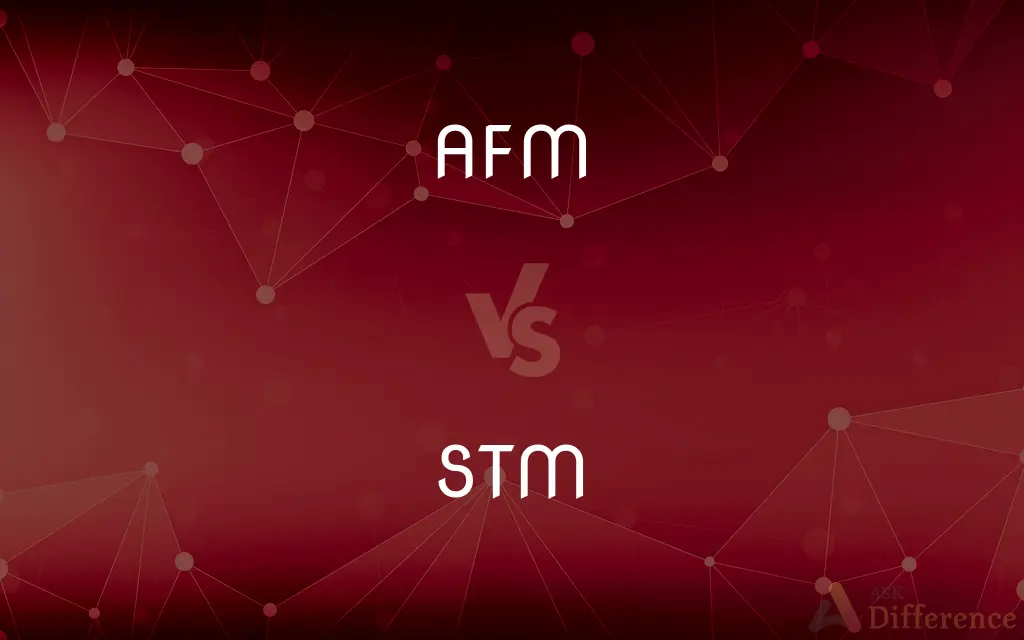AFM vs. STM — What's the Difference?
Edited by Tayyaba Rehman — By Fiza Rafique — Published on December 30, 2023
AFM (Atomic Force Microscopy) measures surface interactions; STM (Scanning Tunneling Microscopy) senses electron flow between tip and sample.

Difference Between AFM and STM
Table of Contents
ADVERTISEMENT
Key Differences
AFM, which stands for Atomic Force Microscopy, is a type of microscopy that uses a sharp tip to probe and interact with a surface, allowing it to image surfaces at the nanometer scale. STM, which stands for Scanning Tunneling Microscopy, also uses a sharp tip, but it senses the flow of electrons between the tip and the sample to create an image.
Both AFM and STM are powerful tools in the field of nanotechnology. While AFM can operate in various environments including air, liquid, or vacuum, STM requires a vacuum or specific conditions to function effectively. The AFM works by measuring the interaction forces between the tip and the sample, whereas STM is based on quantum tunneling of electrons.
AFM provides a 3D topographic map of a surface and is often preferred for studying biological samples or materials that are poor conductors of electricity. STM, on the other hand, requires the sample to be conductive. STM is particularly useful for studying electronic properties at the atomic level.
In conclusion, both AFM and STM are instrumental in advancing nanotechnology research. While AFM provides versatility in sample environments and can image insulating materials, STM is restricted to conductive samples and offers unique insights into electronic behaviors.
Comparison Chart
Full Form
Atomic Force Microscopy
Scanning Tunneling Microscopy
ADVERTISEMENT
Measurement
Surface interactions
Electron flow between tip and sample
Environment
Operates in air, liquid, or vacuum
Requires vacuum or specific conditions
Sample Type
Can image insulating materials
Requires conductive samples
Main Use
3D topographic mapping, diverse materials
Studying electronic properties at atomic level
Compare with Definitions
AFM
An imaging process that doesn't require the sample to be conductive.
The organic material was easily studied using AFM due to its non-conductive nature.
STM
A tool that operates effectively under vacuum conditions.
For their STM experiments, the lab had to ensure a high-quality vacuum environment.
AFM
A microscopy technique that uses a sharp tip to scan and interact with surfaces.
The scientist used the AFM to get detailed images of the cell membrane.
STM
An approach to visualize atomic-scale electronic structures.
STM revealed unexpected electronic patterns in the newly developed alloy.
AFM
A method to visualize nanoscale surface topography.
AFM images showed the detailed structure of the crystalline surface.
STM
A technique requiring the sample to be conductive for imaging.
They switched to STM due to the conductivity of their metallic samples.
AFM
A tool that measures atomic-level forces between a probe and a sample.
By utilizing AFM, they identified variations in surface roughness.
STM
A microscopy method that images surfaces based on electron tunneling.
STM allowed the researchers to observe atomic arrangements on the metal surface.
AFM
A technique sensitive to mechanical properties of the sample surface.
The team used AFM to analyze the elasticity of the polymer samples.
STM
A process sensitive to electronic properties of the surface.
The team exploited STM to study the charge distribution in the semiconductor.
STM
What you can repeat immediately after perceiving it
Common Curiosities
What's the primary function of STM?
STM, or Scanning Tunneling Microscopy, images surfaces based on electron tunneling.
What does AFM stand for?
AFM stands for Atomic Force Microscopy.
What kind of image does AFM produce?
AFM provides a 3D topographic map of a surface.
How does STM differentiate from AFM in measurement technique?
While AFM measures surface interactions, STM senses the flow of electrons between the tip and the sample.
Can AFM work with non-conductive materials?
Yes, AFM can image insulating or non-conductive materials.
Does STM require the sample to be conductive?
Yes, STM requires the sample to be conductive for effective imaging.
Are both AFM and STM used in nanotechnology research?
Yes, both AFM and STM are pivotal tools in nanotechnology research.
In which environment does STM typically operate?
STM typically requires a vacuum or specific conditions to operate.
Is AFM restricted to any specific environment?
AFM can operate in various environments, including air, liquid, or vacuum.
Can STM provide 3D topographical images like AFM?
STM mainly provides 2D images related to electronic properties, while AFM provides 3D topographic images.
Which microscopy method is more versatile in terms of sample environment?
AFM is more versatile as it can work in air, liquid, or vacuum.
Which technique would be suitable for studying biological samples?
AFM is often preferred for studying biological samples due to its versatility.
Are there any samples unsuitable for STM analysis?
Yes, non-conductive or insulating samples are typically unsuitable for STM analysis.
What is the main advantage of using STM?
STM offers unique insights into electronic behaviors at the atomic level.
Can AFM analyze mechanical properties of a sample?
Yes, AFM is sensitive to mechanical properties like elasticity or stiffness of the sample surface.
Share Your Discovery

Previous Comparison
Federalists vs. Democratic Republicans
Next Comparison
Fickian Diffusion vs. Non Fickian DiffusionAuthor Spotlight
Written by
Fiza RafiqueFiza Rafique is a skilled content writer at AskDifference.com, where she meticulously refines and enhances written pieces. Drawing from her vast editorial expertise, Fiza ensures clarity, accuracy, and precision in every article. Passionate about language, she continually seeks to elevate the quality of content for readers worldwide.
Edited by
Tayyaba RehmanTayyaba Rehman is a distinguished writer, currently serving as a primary contributor to askdifference.com. As a researcher in semantics and etymology, Tayyaba's passion for the complexity of languages and their distinctions has found a perfect home on the platform. Tayyaba delves into the intricacies of language, distinguishing between commonly confused words and phrases, thereby providing clarity for readers worldwide.











































